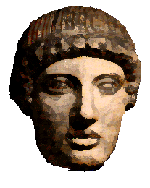Greece 1971
Delphi to Olympia
Such was the Meteora experience that it seems to have totally obliterated any memory I might have had 40 years on of the next few days. The only remaining fragment of my first visit to Delphi is, I'm ashamed to say, the evening Patrick and I spent drinking ouzo in the "Tourist Pavilion", and the black marks we earned for sleeping in the minibus. I do recall the ferry journey across the gulf of Corinth from Rio to Andirio (now replaced by a superb suspension bridge), watching Patrick fast asleep on the minibus roof (unsurprising after last night's merrymaking!).
Next stop was Olympia, where we camped on a crowded site and found the ruins confusing (I was better prepared when I next visited). It was at Olympia that these pictures of us eating were taken, I believe.
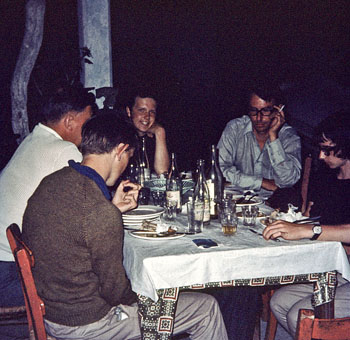 | 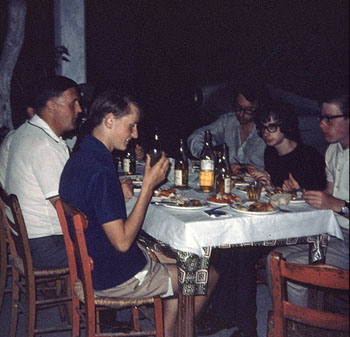 |
| Left to right: Philip Grattidge, Richard Janko, Braidwood, AMW, Pete Sheppard, Chris Smale | |
Bassae and Andritsena
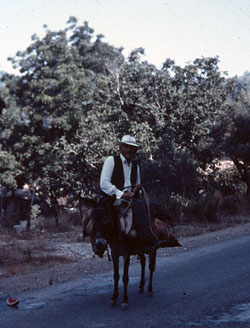 Memory still vividly evokes our journey onward from Olympia. Roads deteriorated and donkeys outnumbered cars as we climbed up towards the remote village of Andritsena. From there it was a further half hour along a dirt track until we had our first glimpse of the Temple of Apollo, alone and unguarded in the Arcadian hills. When I returned in 1996 it was covered in a thick plastic marquee; we had to pay, and there was a shop and carpark. In 1971 it was just us, and the temple was still the kind of romantic ruin which must have inspired the likes of David Roberts - or even earlier of Claude and Poussin.
Memory still vividly evokes our journey onward from Olympia. Roads deteriorated and donkeys outnumbered cars as we climbed up towards the remote village of Andritsena. From there it was a further half hour along a dirt track until we had our first glimpse of the Temple of Apollo, alone and unguarded in the Arcadian hills. When I returned in 1996 it was covered in a thick plastic marquee; we had to pay, and there was a shop and carpark. In 1971 it was just us, and the temple was still the kind of romantic ruin which must have inspired the likes of David Roberts - or even earlier of Claude and Poussin.
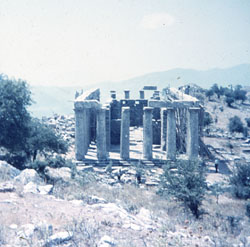 From the hilltop you could see scattered across the landscape (the only man-made objects visible) a number of paved circular platforms: threshing floors used to thresh and winnow grain in days gone by (no sign then of any agriculture beyond olive trees). The dizzy donkeys would release the grain itself, while the wind carried away the chaff. Richard and I at once thought "theatres!". We imagined the workers gathering after the harvest to celbrate with singing and dancing, while others watched ... [2011: saw similar threshing floors in the Serranía de Ronda in Andalucia]
From the hilltop you could see scattered across the landscape (the only man-made objects visible) a number of paved circular platforms: threshing floors used to thresh and winnow grain in days gone by (no sign then of any agriculture beyond olive trees). The dizzy donkeys would release the grain itself, while the wind carried away the chaff. Richard and I at once thought "theatres!". We imagined the workers gathering after the harvest to celbrate with singing and dancing, while others watched ... [2011: saw similar threshing floors in the Serranía de Ronda in Andalucia]
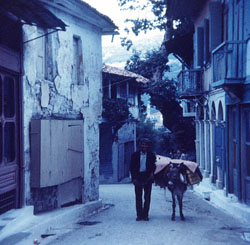 We drove carefully back down to Andritsena for lunch - a stew of unidentifiable chewy substance (?meat) in a sinister black broth: a meal straight from ancient times. And washed down with the roughest wine I've ever tasted - before or since. Strangely - alone of the party - I really enjoyed it!
We drove carefully back down to Andritsena for lunch - a stew of unidentifiable chewy substance (?meat) in a sinister black broth: a meal straight from ancient times. And washed down with the roughest wine I've ever tasted - before or since. Strangely - alone of the party - I really enjoyed it!
A stroll after lunch round the village produced some fascinating glimpses of rural life: the large field (equivalent of the carpark) where donkeys were tethered while their owners went to market; the blacksmith's, where broken-down donkeys were patched up; the sale - a live, small black piglet was being eased into a blue plastic bag, and then loaded, shrilly protesting on to the shopper's donkey. We immediately pictured the scene in the Acharnians where the Megarian was selling his pig-in-a-poke. A plastic bag would have ruined his plans! We found, amazingly, a bookshop, displaying classics of world literature (I remember Victor Hugo) behind dusty glass.
Megalopolis and Methoni
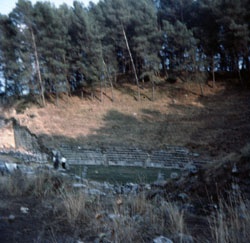 Thence onward through the crushing afternoon heat (it was August), pausing briefly to examine the Frankish castle in the stunningly-sited medieval village of Karitaina (where 30 years later Hopey and I unsuccessfully searched for a room). Around the time that English people take their afternoon tea (as Thucydides might have said), we reached the overgrown village of Megalopolis. We tried to imagine the vast theatre - the largest in Greece - filled with an expectant audience: did this ever happen, we wondered? It was a quiet place, seemingly quite ready to let nature take its course and hide her with weeds and undergrowth. We spent the night there in an actual hotel (no stars, though) - whose best feature was a terrace at the back, giving us a free view of the open-air cinema, showing a western in English with Greek sub-titles (or do I imagine this?).
Thence onward through the crushing afternoon heat (it was August), pausing briefly to examine the Frankish castle in the stunningly-sited medieval village of Karitaina (where 30 years later Hopey and I unsuccessfully searched for a room). Around the time that English people take their afternoon tea (as Thucydides might have said), we reached the overgrown village of Megalopolis. We tried to imagine the vast theatre - the largest in Greece - filled with an expectant audience: did this ever happen, we wondered? It was a quiet place, seemingly quite ready to let nature take its course and hide her with weeds and undergrowth. We spent the night there in an actual hotel (no stars, though) - whose best feature was a terrace at the back, giving us a free view of the open-air cinema, showing a western in English with Greek sub-titles (or do I imagine this?).
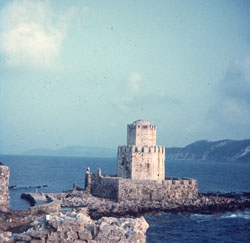 It was now about 10 days since we left Bedford - 10 days without a bath: we headed for the seaside. We spent 3 days at Methoni, on the southern tip of the Peloponnese, camping on the beach, swimming and enjoying wonderful seafood. Some of the taverna's tables and chairs were actually in the sea - a fellow diner amazed us by reaching into the water, and coming up with a large octopus in his fist. Having bashed it vigorously on a convenient rock, the beast was sent to the kitchen. Fresher than that you cannot get!
It was now about 10 days since we left Bedford - 10 days without a bath: we headed for the seaside. We spent 3 days at Methoni, on the southern tip of the Peloponnese, camping on the beach, swimming and enjoying wonderful seafood. Some of the taverna's tables and chairs were actually in the sea - a fellow diner amazed us by reaching into the water, and coming up with a large octopus in his fist. Having bashed it vigorously on a convenient rock, the beast was sent to the kitchen. Fresher than that you cannot get!
Food in Greece was usually better that what we had at Andritsena, but was seldom exciting: normally some kind of meat-ball/rissole with tomato salad doused in olive oil. The students were half-hearted in their appreciation (not even too keen on the fresh sardines - eaten whole - at Methoni) - but presumably the bread kept them alive. Occasionally there was yaourti - and the souvlaki from street stalls in the larger centres was much enjoyed (the now universal "doner kebab" was at that time unknown in the UK).
Sparta to Tolon
Well rested, we were ready to move on: via Nestor's palace near Pylos then over Taÿgetus to Mistra and then Sparta. There we had our most luxurious night yet, in the pleasant Hotel Cecil, to which Hopey and I returned in 1996 (see photo taken from the balcony of snow-covered mountains). We seem to have taken the prevalent though erroneous view (derived from Thucydides) that there's nothing worthg seeing in Sparta. A quick tour of the museum next morning, and we were off. The hot drive through Arcadia was memorable for one thing: we could see from far off under the only tree on the dusty plain a person holding out something - something for sale. Maybe a cold drink, or at least a sandwich, we hoped. As we got close though it was nothing of the kind: it was a live tortoise. And there were several more tortoise-mongers along the road as we pressed northwards.
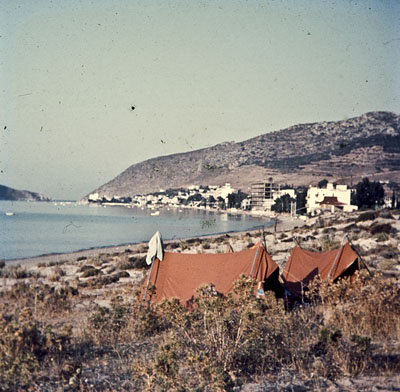 By evening, after brief stops in Tegea and Tiryns (great view of the prison next door), we at the seaside again - at Tolon, then a tiny cvillage, but now a major tourist resort. We camped on dunes to the east of the village, where tourist towerblocks now loom. Tolon was our base to explore Epidaurus and Mycenae - both sites then fully accesible and uncrowded. We returned one evening to the theatre at Epidaurus to see a production in modern Greek of Aeschylus' Persae. The audience was all ready for the performance to begin when a large black limousine drove across the orchestra, and deposited a VIP in the centre of the front row: it was Col. G. Papadopoulos in person. I have a picture somewhere cut from an old magazine showing Benito Mussolini watching Sophocles' Antigone being performed in one of the ancient theatres in Libya - an equally unwelcome intrusion at a democratic event. G.P was to get his come-uppance, though. Pehaps the best known lines in the play are these: the Persian queen is asking who are the Athenians that are making trouble for her son Xerxes.
By evening, after brief stops in Tegea and Tiryns (great view of the prison next door), we at the seaside again - at Tolon, then a tiny cvillage, but now a major tourist resort. We camped on dunes to the east of the village, where tourist towerblocks now loom. Tolon was our base to explore Epidaurus and Mycenae - both sites then fully accesible and uncrowded. We returned one evening to the theatre at Epidaurus to see a production in modern Greek of Aeschylus' Persae. The audience was all ready for the performance to begin when a large black limousine drove across the orchestra, and deposited a VIP in the centre of the front row: it was Col. G. Papadopoulos in person. I have a picture somewhere cut from an old magazine showing Benito Mussolini watching Sophocles' Antigone being performed in one of the ancient theatres in Libya - an equally unwelcome intrusion at a democratic event. G.P was to get his come-uppance, though. Pehaps the best known lines in the play are these: the Persian queen is asking who are the Athenians that are making trouble for her son Xerxes.
τίς δὲ ποιμάνωρ ἔπεστι κἀπιδεσπόζει στρατῷ;
οὔτινος δοῦλοι κέκληνται φωτὸς οὐδ᾽ ὑπήκοοι.Atossa: Who's the shepherd over them? Who's their master?
Chorus: They are not called the slaves or subjects of any man.
The entire audience burst into spontaneous, rapturous applause. G.P. had to sit there and take it.
At Mycenae there were coaches: "Chat Tours" keeping their engines running for a quick getaway to the next sight (rather than site). But compared with today, visitors were still sparse, and one could clamber at will. I remember very clearly going down into the cistern - next time I brought a torch!
Back to part 1 Continue north to Athens - and thence to Crete.

